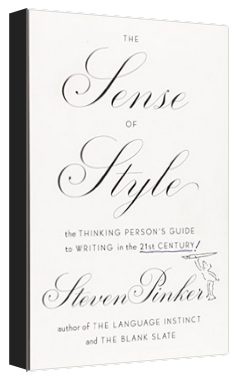The Sense of Style by Steven Pinker: a worthwhile writing guide
 I just finished Steven Pinker’s book on writing style. I like Pinker’s take on writing; I learned a lot from it. It’s a great guide and you should read it, but be aware that business writers need to bring a different and more practical perspective to the advice in this book.
I just finished Steven Pinker’s book on writing style. I like Pinker’s take on writing; I learned a lot from it. It’s a great guide and you should read it, but be aware that business writers need to bring a different and more practical perspective to the advice in this book.
Harvard psychologist Steven Pinker is a distinguished writer and chair of the usage panel of the American Heritage Dictionary. His prose is lively, and I felt as if I were learning from a master. There is quite a lot to learn from The Sense of Style.
He bases his description on “classic style,” which he loosely defines this way:
The guiding metaphor of classic style is seeing the world. The writer can see something that the reader has not yet noticed, and he orients the reader’s gaze so that she can see it for herself. The purpose of writing is presentation, and its motive is disinterested truth. . . .
The writer of classic prose must simulate two experiences: showing the reader something in the world, and engaging her in conversation.
This is a very nice idea. I like to read books written this way because they are entertaining and interesting. They are not necessarily efficient and practical, though, a distinction that Pinker makes clear as he describes the differences between classic and practical style. (I’ll return to that crucial distinction at the end of this post.)
There’s plenty to like here. For example: a plea for writers to draw attention to their subject, not to themselves, and not to spend a lot of time whining about how complicated their topic is (an observation, I’m sure, that comes from reading a lot of academic writing). I also love Pinker’s prescription about hedging:
Many writers cushion their prose with wads of fluff that imply that they are not willing to stand behind what they are saying, including almost, apparently, comparatively, fairly, in part, nearly, partially, predominantly, presumably, rather, relatively, seemingly, so to speak, somewhat, sort of, to a certain degree, to some extent, and the ubiquitous I would argue . . . .Writers acquire the hedge habit to conform to the bureaucratic imperative that is abbreviated as CYA, which I’ll spell out as Cover Your Anatomy.
Tell it, Steven.
The whole second chapter of The Sense of Style is filled with great advice on topics like eschewing hedges, minimizing abstractions, avoiding “zombie nouns” (assessment, comprehension, exclusion), and using personal pronouns (“I” and “you”).
Pinker is not quite as incensed about the passive voice as I am, and I agree with him that it has its place. But we both put it into the category of writing tics that obscure meaning and directness. Here’s what he has to say about a warning sticker on a portable generator and an improvement upon it:
. . . [P]eople with health conditions are more easily affected by Carbon Monoxide and their symptoms are more severe . . . Much better is this sticker found on a recent model: Using a generator indoors CAN KILL YOU IN MINUTES.
Yup. Much clearer.
Chapter 3, “The Curse of Knowledge,” reveals the main scourge of bad writing: the author’s burden of knowing so much that they can’t imagine what’s it’s like to be the poor, ignorant reader. As Pinker says, “The curse of knowledge is the single best explanation I know of why good people write bad prose.” This explains the profusion of jargon: “. . . why specialists use so much idiosyncratic terminology, together with abstractions, metaconcepts, and zombie nouns. They are not trying to bamboozle us; that’s just the way they think.” You can’t write better until you learn the source of your problem, and I think Pinker has nailed it.
Chapters 4 and 5, on syntax and connecting ideas together, were tough going. They felt obvious and even a bit tedious to me. But perversely, I fell in love once again in the final chapter, Chapter 6, which is nothing more than an official guide to correct language rules. You might find this stuff boring, but it’s not at all dry. Here’s where Pinker adroitly and incontrovertibly dismantles myths about split infinitives, dangling modifiers, subjunctives, prepositions at the end of a sentence, like vs. as, and even the singular they. I felt as if someone had come up along side of me, reassured me that all my various habits and exceptions were all right after all, and sent me on way with the happy endorsement of an expert. Keep this chapter by your side and you can do battle with copyeditors that have strayed too far into the stickler section of the bleachers.
Naturally, as I read his book, I asked myself: do these rules apply to my audience? Now that The Sense of Style exists, is there any need for my upcoming book?
Pinker answers this himself as he distinguishes classic style from “practical style,” which is “the language of memos, manuals, term papers, and research reports.” But I’m not as quick as Pinker is to write off the “style” in practical style. In fact, you could say it is my job to define it. I believe practical writing can be both elegant and get straight to the point; in fact, I think these goals reinforce one another. And that’s what I’ll be explaining.
In the meantime, you should go get a copy of The Sense of Style, read it all except chapters 4 and 5, and take it to heart. You’ll be a lot better writer if you do.
Photo: Amazon.com